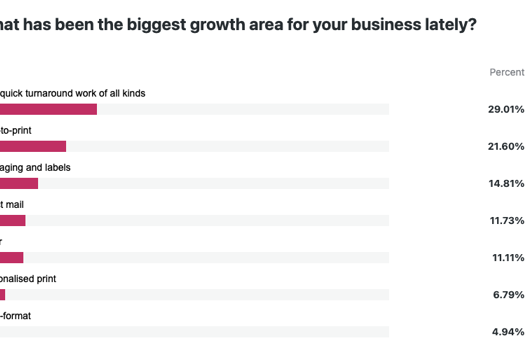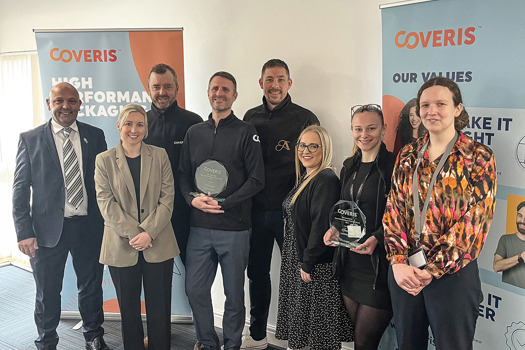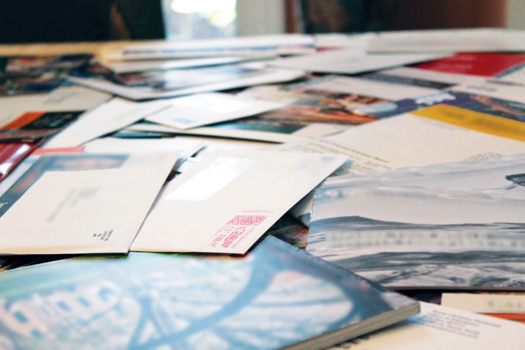In essence, the company wanted to produce a piece of promotional material that illustrated what it could do as a company – to show that letterpress could deliver impressive results. It asked designer Kerr Vernon to help it produce a range of design ideas to show off the technique. After running though his suggestions, the firm settled on cassette tape-style box that contained a set of six music-themed cards, each showcasing a variety of print effects.
How was the job produced?
The company’s Heidelberg Platen was used to print the piece. Modified platens were also used for die-cutting and stamping for the metallic and holographic foiling used on some of the cards. For the job, the company used GF Smith’s Colorplan 540gsm board, which Glasgow Press said was an "ideal substrate".
What challenges were overcome?
The company said that the processes used were not a problem, hardly surprising as it focused on the techniques it specialised in. However, it’s biggest challenge was fitting the job in and around its normal day-to-day output. As a result, the production of the final 750 sets took more than a month to complete.
What was the feedback?
According to the company: stunning. Within 48 hours it had sent out close to 500 samples, many of them to existing or lapsed customers. While it’s too early for the firm to quantify the work the campaign secured, it has already received requests for samples from top brands such as Apple, Vogue and Sony – so the signs are good.
Killer app: Letterpress fanatics’ promo piece is music to your eyes
Scottish letterpress printer Glasgow Press recently produced a promotional campaign to highlight the impact letterpress can have in creative marketing executions.
What did the company do?
In essence, the company wanted to produce a piece of promotional material that illustrated what it could do as a company – to show that letterpress could deliver impressive results. It asked designer Kerr Vernon to help it produce a range of design ideas to show off the technique. After running though his suggestions, the firm settled on cassette tape-style box that contained a set of six music-themed cards, each showcasing a variety of print effects.
How was the job produced?
The company’s Heidelberg Platen was used to print the piece. Modified platens were also used for die-cutting and stamping for the metallic and holographic foiling used on some of the cards. For the job, the company used GF Smith’s Colorplan 540gsm board, which Glasgow Press said was an "ideal substrate".
What challenges were overcome?
The company said that the processes used were not a problem, hardly surprising as it focused on the techniques it specialised in. However, it’s biggest challenge was fitting the job in and around its normal day-to-day output. As a result, the production of the final 750 sets took more than a month to complete.
What was the feedback?
According to the company: stunning. Within 48 hours it had sent out close to 500 samples, many of them to existing or lapsed customers. While it’s too early for the firm to quantify the work the campaign secured, it has already received requests for samples from top brands such as Apple, Vogue and Sony – so the signs are good.Killer app: Letterpress fanatics’ promo piece is music to your eyes
Scottish letterpress printer Glasgow Press recently produced a promotional campaign to highlight the impact letterpress can have in creative marketing executions.
What did the company do?
In essence, the company wanted to produce a piece of promotional material that illustrated what it could do as a company – to show that letterpress could deliver impressive results. It asked designer Kerr Vernon to help it produce a range of design ideas to show off the technique. After running though his suggestions, the firm settled on cassette tape-style box that contained a set of six music-themed cards, each showcasing a variety of print effects.
How was the job produced?
The company’s Heidelberg Platen was used to print the piece. Modified platens were also used for die-cutting and stamping for the metallic and holographic foiling used on some of the cards. For the job, the company used GF Smith’s Colorplan 540gsm board, which Glasgow Press said was an "ideal substrate".
What challenges were overcome?
The company said that the processes used were not a problem, hardly surprising as it focused on the techniques it specialised in. However, it’s biggest challenge was fitting the job in and around its normal day-to-day output. As a result, the production of the final 750 sets took more than a month to complete.
What was the feedback?
According to the company: stunning. Within 48 hours it had sent out close to 500 samples, many of them to existing or lapsed customers. While it’s too early for the firm to quantify the work the campaign secured, it has already received requests for samples from top brands such as Apple, Vogue and Sony – so the signs are good.
Scottish letterpress printer Glasgow Press recently produced a promotional campaign to highlight the impact letterpress can have in creative marketing executions.
What did the company do?
In essence, the company wanted to produce a piece of promotional material that illustrated what it could do as a company – to show that letterpress could deliver impressive results. It asked designer Kerr Vernon to help it produce a range of design ideas to show off the technique. After running though his suggestions, the firm settled on cassette tape-style box that contained a set of six music-themed cards, each showcasing a variety of print effects.
How was the job produced?
The company’s Heidelberg Platen was used to print the piece. Modified platens were also used for die-cutting and stamping for the metallic and holographic foiling used on some of the cards. For the job, the company used GF Smith’s Colorplan 540gsm board, which Glasgow Press said was an "ideal substrate".
What challenges were overcome?
The company said that the processes used were not a problem, hardly surprising as it focused on the techniques it specialised in. However, it’s biggest challenge was fitting the job in and around its normal day-to-day output. As a result, the production of the final 750 sets took more than a month to complete.
What was the feedback?
According to the company: stunning. Within 48 hours it had sent out close to 500 samples, many of them to existing or lapsed customers. While it’s too early for the firm to quantify the work the campaign secured, it has already received requests for samples from top brands such as Apple, Vogue and Sony – so the signs are good.Killer app: Letterpress fanatics’ promo piece is music to your eyes
Scottish letterpress printer Glasgow Press recently produced a promotional campaign to highlight the impact letterpress can have in creative marketing executions.
What did the company do?
In essence, the company wanted to produce a piece of promotional material that illustrated what it could do as a company – to show that letterpress could deliver impressive results. It asked designer Kerr Vernon to help it produce a range of design ideas to show off the technique. After running though his suggestions, the firm settled on cassette tape-style box that contained a set of six music-themed cards, each showcasing a variety of print effects.
How was the job produced?
The company’s Heidelberg Platen was used to print the piece. Modified platens were also used for die-cutting and stamping for the metallic and holographic foiling used on some of the cards. For the job, the company used GF Smith’s Colorplan 540gsm board, which Glasgow Press said was an "ideal substrate".
What challenges were overcome?
The company said that the processes used were not a problem, hardly surprising as it focused on the techniques it specialised in. However, it’s biggest challenge was fitting the job in and around its normal day-to-day output. As a result, the production of the final 750 sets took more than a month to complete.
What was the feedback?
According to the company: stunning. Within 48 hours it had sent out close to 500 samples, many of them to existing or lapsed customers. While it’s too early for the firm to quantify the work the campaign secured, it has already received requests for samples from top brands such as Apple, Vogue and Sony – so the signs are good.










